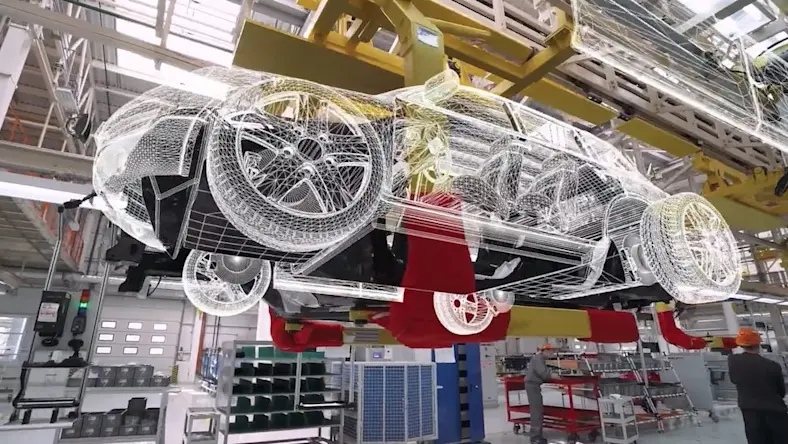& Construction

Integrated BIM tools, including Revit, AutoCAD, and Civil 3D
& Manufacturing

Professional CAD/CAM tools built on Inventor and AutoCAD
As times change, the manufacturing industry is reinventing itself.
It has to in order to survive—especially for traditional manufacturers such as Bosch, a 130-year-old company built around the automotive assembly line. To that end, the Bosch factory in Mondeville, France, which does large production runs of electronics for the automotive industry, is deploying digital tools in all of its workshops and connecting systems for better productivity.
But creating a factory of the future requires more than just evolving to stay competitive; it means working with today’s challenges (like high energy and labor costs) with an eye on progress and persistence. Here are four ways Bosch Mondeville has transformed its factory model today—for tomorrow.
“We’ve gradually moved from mass production to industrializing innovative products,” says Théophile Guettier, project manager for 3D design at Bosch Mondeville. To shift from its original setup for manufacturing automotive electronics, the site has gone through a digital transformation, adding skills to support companies seeking to industrialize small- and medium-scale production runs in record time.
“Integrating certain software programs into our production has changed everything,” says Pierre Bagnon, director of electronic manufacturing service (EMS). “These programs have enabled us to reproduce our operators’ know-how while allowing all of us to enhance our own skills.”
Bosch Mondeville has extended its expertise in automobile electronics to certain niche markets—such as manufacturing active antenna arrays for Sigfox, a communication specialist for IoT, and top-of-the-line hi-fi speakers by Devialet.
Adopting a “manufacturing as a service” model, the Mondeville factory focuses on adding strength and sustainability to Devialet’s production system. This partnership, which requires precision manufacturing with high-performance materials, represents a turning point for the Mondeville site (winner of the Factory of the Year 2017 award from L’Usine N ouvelle, a weekly French business and technology magazine).
Digital technology, once used mostly for research purposes at Bosch, has spread to workshops where dozens of employees manufacture products in small production runs. “It may seem odd, but manual labor is back thanks to digital technology,” Bagnon says.
Although assembly line automation has reduced the number of operators per position, digital technology has brought back the human element to the production lines. In real terms, the product lands in the operator’s hands after it has been identified through its RFID chip. Once the editing station is connected, the assembly lines appear on a screen. Light guides then help the operator place the pieces correctly and in the right order; this allows for a manual assembly that limits the risk of error to the lowest level possible.
“In addition to the operator’s attention to detail, production is controlled electronically,” Bagnon says. “Sensors on the assembly bench communicate with the system via ultrasound. If, for example, a part is installed in the incorrect order, an error message appears on the screen alerting the operator.”
Currently, more than 600 employees are working in this new digital environment. “Our activities continue to grow steadily,” Bagnon says. “Dozens of our clients are able to extend the range of their products, maintaining high-quality production in small runs.”
“Manufacturing in short runs with a high level of innovation gives us an opportunity to expand our service offer,” Bagnon says of the Mondeville plant, noting that software tools such as Autodesk Fusion 360 and Meshmixer have played a major role. “From the very beginning, they allowed us to industrialize a production run adapted from the previous one with greater ease and at a higher rate.”
The engineering and product-development teams at Bosch have worked with the line operators to improve production by setting up predictive maintenance and other smart tools supporting the workers, such as Bosch APAS collaborative robots, connected bins for bulk components, and so forth. “We needed to respond quickly to new customers who had never really worked with Bosch before,” Bagnon says. “With the support of each of the factory services involved, we have built our new studio around this relationship.”
Bosch hired new engineers and sales reps in order to match client requirements with the Bosch organization. By reorganizing its factory site, the teams at Bosch Mondeville have focused on these new customer relationships in the drafting and design phases. The Bosch teams exchange information with clients on the different limitations in production, creating conditions for increased productivity. Now, Bosch Mondeville can produce either big volumes or small serials with high customization.
Integrating a digital workshop unit, similar to a “fab lab,” into factory production has given Bosch the flexibility to work with a range of clients. It operates much like a startup that encompasses both Bosch employees and external clients such as Safran, Zodiac Aerospace, and Agrial.
This approach allows Bosch Mondeville to not only develop new products based on its existing catalog but also respond more quickly to urgent requests to produce new parts that are increasingly technical and innovative.
In one example, Bosch’s 3D-printing capability has attracted a project to create customized splints for the medical industry. “For this project, we needed software that allows us to work like sculptors, and Meshmixer offers the ability to use organic shapes,” Bagnon says. “Based on medical scans, this solution allows us to design a system that is perfectly adapted to the patient’s body.”
Devialet is a sound-technology startup founded in 2007 and based in Paris. The company’s original technology, Analog Digital Hybrid (ADH), is a patented amplification invention that helped bridge the gap between analog and digital technology, offering sound quality without distortion, saturation, or noise.
In 2010, Devialet introduced a line of hi-fi amplifiers, and in early 2015, after successfully downsizing its technology, it introduced Phantom, designed for an ultradense physical sound impact.
Striving to make its products more accessible, Devialet has developed and industrialized Phantom, which has been available in Apple stores since December 2015. In 2016, to meet the challenge of large-scale production, Devialet partnered with Bosch Mondeville to produce Phantom.
Maxime Thomas is an editor for the French national and specialized press. He has also worked in radio and covers various aspects of industrial life, including digital transformation and its specific consequences for certain professions.
PD&M
Emerging Tech
Image courtesy of Viessmann.
Emerging Tech







